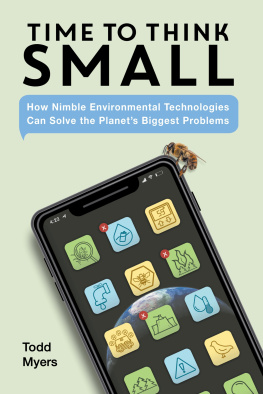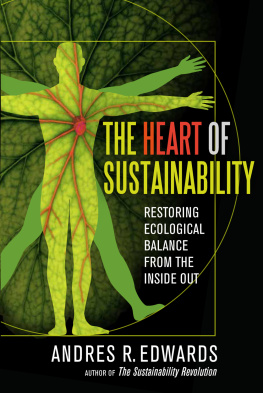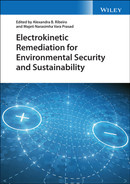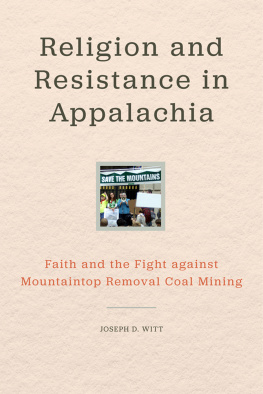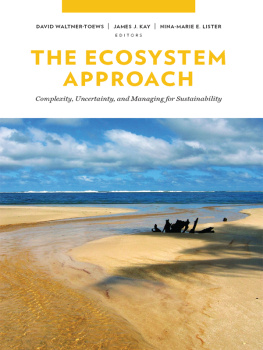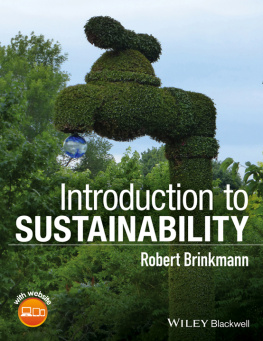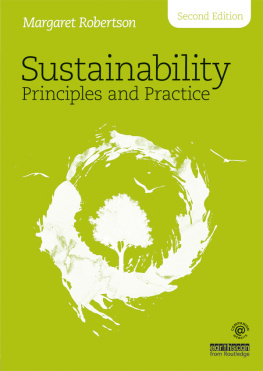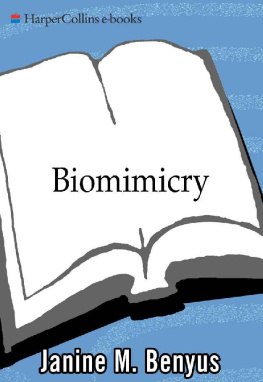
Copyright 2019 by John Todd. All rights reserved. No portion of this book, except for brief review, may be reproduced, stored in a retrieval system, or transmitted in any form or by any meanselectronic, mechanical, photocopying, recording, or otherwisewithout the written permission of the publisher. For information contact North Atlantic Books.
Published by
North Atlantic Books
Berkeley, California
Cover photo of Fjardargljufur Canyon, Iceland, by Ratnakorn Piyasirisorost
Cover design by Nicole Hayward
Book design by Happenstance Type-O-Rama
Printed in the United States of America
Healing Earth: An Ecologists Journey of Innovation and Environmental Stewardship is sponsored and published by the Society for the Study of Native Arts and Sciences (dba North Atlantic Books), an educational nonprofit based in Berkeley, California, that collaborates with partners to develop cross-cultural perspectives, nurture holistic views of art, science, the humanities, and healing, and seed personal and global transformation by publishing work on the relationship of body, spirit, and nature.
North Atlantic Books publications are available through most bookstores. For further information, visit our website at www.northatlanticbooks.com or call 800-733-3000.
Library of Congress Cataloging-in-Publication Data
Names: Todd, Nancy Jack, 1938- author.
Title: Healing earth : an ecologists journey of innovation and environmental
stewardship / John Todd.
Description: Berkeley, California : North Atlantic Books, [2019] | Includes
index.
Identifiers: LCCN 2018030539 (print) | LCCN 2018044967 (ebook) | ISBN
9781623172992 (e-book) | ISBN 9781623172985 (pbk.)
Subjects: LCSH: Ecological engineering. | Environmental responsibility. |
Environmental protection.
Classification: LCC GE350 (ebook) | LCC GE350 .T63 2019 (print) | DDC
628dc23
LC record available at https://lccn.loc.gov/2018030539
To my family
To Nancy, my partner and colleague in our shared lifes work. She has been my most diligent editor and inspired in me her love of language.
To our three children, Rebecca, Jonathan, and Susannah. They have been a source of support and pure pleasure.
To our grandchildren: Rebeccas sons Max and Gareth; Jonathans daughter, Anissa, and sons Roberto and Quinn; and Susannahs son, Logan. All of them have brought me joy.
The rule of no realm is mine.
But all worthy things that are in peril
as the world now stands, those are my care.
And for my part, I shall not wholly fail in my task
if anything passes through this night
that can still grow fair or bear fruit
and flower again in days to come.
For I too am a steward. Did you not know?
Foreword
It behooves one to pay close attention to the life history of organisms including the fungi, plants, animals, and even the microorganisms. For me natural history is not an old-fashioned form of knowing. It is the narratives of living entities that provide the alphabet of the design vocabulary.
John Todd, from chapter 4 in this book
Something troubling has occurred in the biological sciences over the last few decades, something Rutgers University professor David Ehrenfeld calls the forgetting. The deeper we delve into life at the molecular level, the more we seem to lose touch with the mystery of the whole organism and the community to which it belongs. I have friends who spend their lives decoding the intricate genome of a plant called Arabidopsis. As the mouse-model of botany, and the first plant to have its genome sequenced, Arabidopsis is now the most intensively researched plant on the planet. I like to watch for its elevated stalk, pale flowers, and compact rosette when hiking with my genomic friends. Here it is! I exclaim, eager to watch them marvel at their mentor in the wild. My heart sinks when they ask: What species is that?
Estrangement from the whole makes it hard to appreciate, much less emulate, the systems that keep our planet humming. Thats why its important to hear from John Todd, a consummate student of the whole and a creator of ecological technologies that renew water, soils, air, and, ultimately, human communities. He is an apprentice of ecosystems, and after a lifetime of immersing himself in eelgrass meadows, oak-hickory forests, vernal ponds, and salt marshes, he gifts us with a book of operating instructionsuniversal patterns and principles that allow these ecologies to design, organize, and, most importantly, re-member themselves after insult.
Few people I know have a deeper regard for the wisdom of the natural world, or a bigger heart for the human species. John believes that an ecological renaissance is afoot, and that humans will one day participate in the grand planetary cycles as beneficial contributors. Its not that he is unaware of our current role in the great unraveling. In fact, some of his most profound stories are about discovering leached carcinogens near the homes of two friends lost to cancer, or watching the desecration of landscapes he loved like companions. But rather than shrink from the damage, John wades into the worst and wonders how he can help.
His first instinct is to ask where he might find inspiration, meaning which living ecosystems will best teach him. Finding a wild system that is working beautifully, he climbs, hikes, or snorkels within it, taking a master class in the complex science of healing through relationships. Even during his watery childhood, as a small boy on the edge of a Great Lake, John studied the difference between two streams that accompanied him on his walk to school. One was crystal clear and brimming with life, the other erratic and muddy, stripped of its life by upstream golf courses and housing developments. He trained himself to see how the wild stream managed to run clear year in and year out. It had everything to do with the diversity of life forms in and around it, the cast of characters that define a place and keep it vibrant. Life connected to life can heal anything, says John, even the emergencies of our own making.
I share his belief in lifes genius, and have dedicated my own life to the discipline of biomimicry, which I define as innovation inspired by nature. Surrounding oneself with lifes solutions is like living in a cornucopia of what works. When I encourage people to go beyond the mimicry of just one species or one part of one species, I point to Johns work as an ecomimican innovator who emulates the whole. In this book, you will have a rare opportunity to learn a checklist, still evolving, of the best practices that John has discovered over a lifetime of creating linked healing systems. I found myself highlighting page after page, thrilled to see this one-of-a-kind wisdom gathered and shared.
One of my favorite memories was watching John share his wisdom with a very tense room of exasperated foreign aid workers. We were in Boulder, Colorado, at a design workshop to bring sustainable solutions to refugee camp settings. The Rocky Mountain Institute was hosting along with the Navy, whose leaders were seeing humanitarian missions all over the world become the new military theater as political and climate change refugees fled from brutality, droughts, floods, and fear. People were living for years, even decades, in camps that were designed to last months. How could these not-so-temporary settlements become less wasteful of human spirits and the environment?
We covered a plethora of sustainable technologies such as LED lights and smart cards, but the people most experienced with these crises grew increasingly frustrated, until one day, the whole thing blew up. Veterans of dozens of encampments challenged us to see through their eyes: People are locusts, they said, referring to the damage hundreds of thousands of people can have. People are a plague, and in their desperation, they ruin landscapes and no country wants to have them.
Next page


